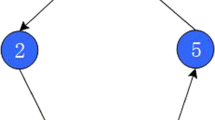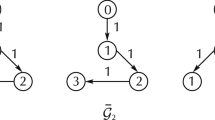Abstract
In this paper, we consider distributed H ∞ consensus problem for multi-agent systems with discrete-time high-dimensional linear coupling dynamics subjected to external disturbances. The interaction topology among the agents is assumed to be switching and undirected. To achieve consensus, a neighbor-based dynamic output feedback protocol is proposed for each agent. By using Schur orthogonal transformation, the considered multi-agent H ∞ consensus control problem is converted into H ∞ control problem of a discrete-time switching subsystem. Based on graph theory and common Lyapunov function method, a sufficient condition in terms of linear matrix inequalities is established to solve H ∞ consensus problem of the considered multi-agent systems. Moreover, the feedback gain matrix can be obtained from the feasible solution to the linear matrix inequalities. Finally, a simulation example is given to illustrate our established theoretical result.

Similar content being viewed by others
References
Murray R.M.: Recent research in cooperative control of multivehicle systems. ASME J. Dyn. Syst. Meas. Control 129, 571–583 (2007)
Ren W., Beard R.W.: Consensus seeking in multi-agent systems using dynamically changing interaction topologies. IEEE Trans. Autom. Control 50(5), 55–661 (2005)
Vicsek T., Czirok A., Jacob E.B., Cohen I., Schochet O.: Novel type of phase transitions in a system of self-driven particles. Phys. Rev. Lett. 75, 1226–1229 (1995)
Jadbabaie, A.; Lin, J.; Morse, A.S.: Coordination of groups of mobile agents using nearest neighbor rules. IEEE Trans. Autom. Control 48(6), 988–1001 (2003)
Xiao F., Wang L.: Consensus problems for high-dimensional multi-agent systems. IET Control Theory Appl. 1(3), 830–837 (2007)
Ni W., Cheng D.: Leader-following consensus of multi-agent systems under fixed and switching topologies. Syst. Control Lett. 59, 209–217 (2010)
Hong Y., Hu J., Gao L.: Tracking control for multi-agent consensus with an active leader and variable topology. Automatica 42(7), 1177–1182 (2006)
Li Z., Duan Z., Chen G.: ynamic consensus of linear multi-agent systems. IET Control Theory Appl. 5(1), 19–28 (2011)
Seo, J.; Shim, H.; Back, J.: Consensus of high-order linear systems using dynamic output feedback compensator: low gain approach. Automatica 45(11), 2659–2664 (2009)
Hatano Y., Medbshi M.: Agreement over random networks. IEEE Trans. Autom. Control 50(11), 1867–1872 (2005)
Ugrinovskii V.: Distributed robust filtering with H ∞ consensus of estimates. Automatica 47, 1–13 (2011)
Xi, J.; Cai, N.; Zhong, Y.: Consensus problems for high-order linear time-invariant swarm systems. Physica A 389(24), 5619–5627 (2010)
Cai, N.; Xi, J.; Zhong, Y.: Swarm stability of high order linear time-invariant swarm systems. IET Control Theory Appl. 5(2), 402–408 (2011)
Shen, B.; Wang, Z.; Liu, X.: Bounded H-infinity synchronization and state estimation for discrete time-varying stochastic complex networks over a finite-horizon. IEEE Trans. Neural Netw. 22(1), 145–157 (2011)
Oh K., Ahn H.: Formation control of mobile agents based on inter-agent distance dynamics. Automatica 47, 2306–2312 (2011)
Gao L., Tang Y., Chen W., Zhang H.: Consensus seeking in multi-agent systems with an active leader and communication delays. Kybernetika 47(5), 773–789 (2011)
Cao Y., Ren W.: Sampled-data discrete-time coordination algorithms for double-integrator dynamics under dynamic directed interaction. Int. J. Control 83, 506–515 (2010)
Li S., Dua H., Lin X.: Finite-time consensus algorithm for multi-agent systems with double-integrator dynamics. Automatica 47, 1706–1712 (2011)
Xiao F., Wang L.: Consensus protocols for discrete-time multi-agent systems with time-varying delays. Automatica 44, 2577–2582 (2008)
Wang, L.; Xiao, F.: Dynamic behavior of discrete-time multi-agent systems with general communication structure. Physical A 370(2), 364–380 (2006)
Lin P., Jia Y.: Consensus of second-order discrete-time multi-agent systems with nonuniform time-delays and dynamically changing topologies. Automatica 45, 2154–2158 (2009)
Li T., Zhang J.: Mean square average-consensus under measurement noises and fixed topologies: necessary and sufficient condition. Automatica 45, 1929–1936 (2009)
Huang M., Manton J.H.: Coordination and consensus of networked agents with noisy measurents: stochastic algorithms and asymptotic behavior. SIAM J. Control Optim. 48, 134–161 (2009)
Lin, P.; Jia, Y.: Distributed robust H ∞ consensus control in directed networks of agents with time-delay. Syst. Control Lett. 57(8), 643–653 (2008)
Hu J., Feng G.: Distrubuted tracking control of leader-follower multi-agent systems under noisy measurement. Automatica 46, 1382–1387 (2010)
Luo, Y.; Gao, L.; Wang, F.: The L 2 − L ∞ control for leader-following coordination with switching topology and time-delay. J. Netw. 5(12), 1513–1520 (2010)
Li, Z.; Duan, Z.; Huang, L.: H ∞ control of networked multi-agent systems. J. Syst. Sci. Complex. 22, 35–48 (2009)
Li, Z.; Duan, Z.; Chen, G.: On H ∞ and H 2 performance regions of multi-agent systems. Automatica 47(4), 797–803 (2011)
Liu Y., Jia Y.: H ∞ control of multi-agent systems with switching topology: a dynamic output feedback protocol. Int. J. Control 83, 527–537 (2009)
Olfati-Saber, R.; Murray, R.M.: Consensus problems in networks of agents with switching topology and time-delays. IEEE Trans. Autom. Control 49(9), 1520–1533 (2004)
Horn, R.; Johnson, C.: Matrix Analysis. New York: Cambridge University Press (1985)
Cao Y., Lam J.: A computational method for simultaneous LQ optimal control design via piecewise constant output feedback. IEEE Trans. Syst. Man Cybern. Part B: Cybern. 31, 836–842 (2001)
Gao, L.; Zhang, J.; Chen, W.: Second-order consensus for multi-agent systems under directed and switching topologies. Math. Probl. Eng. 2012, Article ID 273140, pp. 1–21 (2012)
Boyd, S.; EI Ghaoui, L.; Feron, E.; Balakrishna, V.: Linear Matrix Inequalities in System and Control Theory, SIAM, Philadelphia (1994)
Author information
Authors and Affiliations
Corresponding author
Rights and permissions
About this article
Cite this article
Gao, L., Tong, C. & Wang, L. H ∞ Dynamic Output Feedback Consensus Control for Discrete-Time Multi-Agent Systems with Switching Topology. Arab J Sci Eng 39, 1477–1487 (2014). https://doi.org/10.1007/s13369-013-0807-7
Received:
Accepted:
Published:
Issue Date:
DOI: https://doi.org/10.1007/s13369-013-0807-7




